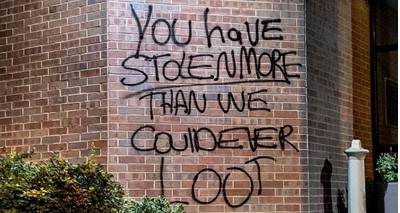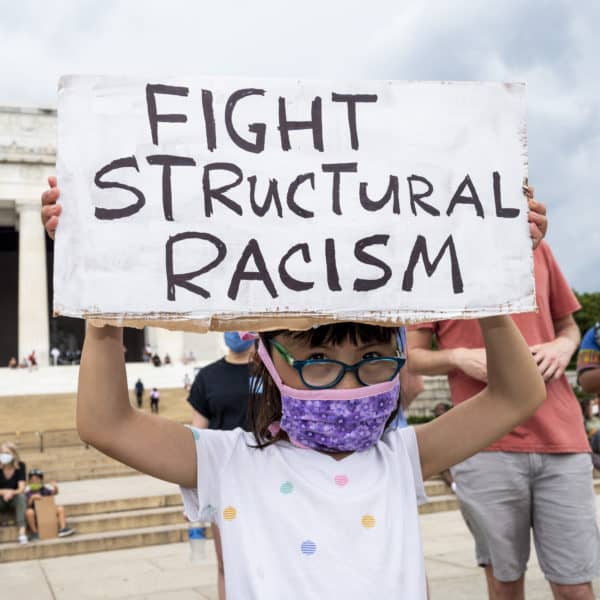Blacks and Whites: We Need a Divorce
Joseph Kay, American Renaissance, September 4, 2020

It is tempting to dismiss the phrases “institutional racism,” “structural racism” and the like as empty rhetoric whose sole purpose is to mobilize simple-minded protesters. This interpretation is mistaken; these phrases really do mean something even though many who repeat them can’t articulate much beyond the slogan.
When blacks talk of overthrowing institutional, structural, or systemic racism, they are not referring to traditional civil rights objectives such as anti-discrimination laws. They are talking about American culture in general. A recent statement from the National Museum of African American History criticized the undesirable traits of “whiteness” that oppress blacks: This compilation included objective, rational, linear thinking (the scientific method, more generally), rugged individualism, self-reliance, the intact nuclear family, a strong work ethic and delayed gratification, respect for authority, following time schedules, Christianity, planning for the future, English common law justice, property rights and being polite. (In response to criticism, the museum took down this list but did not disavow it.)
Thus understood, systemic racism cannot be ended by legislative fixes, let alone billion-dollar schemes to eliminate wealth gaps. It apparently can be ended only by whites abandoning every element of their own way of life. If those who drafted this list are to be believed, African Americans want to be more African and less American.

June 19, 2020, Washington, DC: A Juneteenth Freedom Day march and rally at the National Mall. (Credit Image: © Michael Brochstein / ZUMA Wire)
Here is a different critique. A recent analysis of the tribulations faced by blacks in the academy put it this way: “[I]nstitutions continue to have various administrators — predominantly white — whose primary function is to enforce damage control to ensure that white supremacist structures can be maintained. Rather than developing a new culture of equity and justice, institutions target their diversity workers within the administration, creating purposefully hostile work environments.”
What would be a “new culture of equity and justice”? Abandoning linear thinking and the intact nuclear family? Perhaps not. The authors provide a list of how people of color are marginalized and stigmatized: ignored in decision-making, held to higher standards in teaching and research, and not paid to fight racism. In short, despite all the efforts at accommodation, universities still have “a pervasive culture of toxicity.”
To put the critique of “whiteness” into a broader context, consider the long history of how dominant cultures try to absorb outsiders. Indigestion is common. The failed assimilation of American Indians is infamous whether via semi-autonomous reservations or “Indian Schools” that banned students from speaking their native language. Less publicized is the failed effort to uplift rural Appalachians (“hillbillies” “rednecks”), a group with high rates of drug and alcohol addiction, school failure, and domestic violence. President John Kennedy’s first foray into ending poverty was helping this white group, and President Donald Trump is still trying to help.
Australians were unable to assimilate their Aboriginal population and recently have apologized for even trying. There are also the once nomadic people of Scandinavia — variously called Laplanders or Sami People — who still speak distinctive languages and have kept their identities. The Romani (or Gypsies) in Eastern Europe are equally noteworthy for refusing to become ordinary Romanians, Hungarians, or Bulgarians despite all the usual social engineering schemes.

Ca. 1900: Students at Carlisle Indian Industrial School, Pennsylvania.
These failures probably help explain why many governments have abandoned the forced assimilation of isolated indigenous people such as tribes in Brazil’s Amazon region. This hands-off policy also reflects fear of inadvertent genocide via disease, but it is also recognized that no amount of cultural engineering achieves assimilation. Extensive contact only destroys the once-isolated culture, replacing it with alcoholism, drug addiction, suicide and similar pathologies, all of which impose financial burdens on the larger society.
This is why rejections of “whiteness” should not automatically be dismissed as wrong-headed or anti-American. When it set up reservations, the federal government accepted the reality that American Indians are never going to assimilate to society’s “white” dominant values. At least some blacks seem to be insisting on a comparable status.
Can middle-class experts legitimately claim that what they consider an undesirable tangle of criminality, drug addiction, illegitimacy etc., is not a culture? Those living in this “toxic” milieu could claim that their way of life is just as much a culture as to be a WASP. People arguably have a right to embrace their own values regardless of ruinous consequences. Insisting that one culture outshines another is self-congratulation. Replacing the rule of law with spontaneous violence may produce a miserable Hobbesian existence, but shootouts that settle arguments may be acceptable in some cultures. Not everybody wants to hire lawyers and litigate. For the poor, wild-west retribution may be economically cost-effective. For millennia, personal violence was how Europeans settled disputes; the rule of law is a recent innovation.
The National Museum of African American History experts could invoke evolutionary biology to defend themselves against what they see as an imposed “foreign” white culture. The monogamous nuclear family widely hailed as the cure for the black underclass may not be advantageous in all settings. Ozzie and Harriet-style monogamy may be a bad choice if life is short, and if getting genes into the next generation is the goal, it’s better to spawn a large brood with many partners. Careful planning may be counter-productive in times of perpetual chaos, and after surviving 300,000 years in semi-anarchy (versus a few centuries in a more orderly environment), an aversion to planning may become genetically hard-wired. Schoolmarmish lectures about marriage before children and similar bourgeois habits can inspire anger, not thankfulness for “good advice” among those whose instincts counsel otherwise.

No bourgeois habits needed: A witch doctor of the Shona people in Zimbabwe. (Credit Image: Hans Hillewaert)
Moreover, what do you advise those who have repeatedly failed to embrace “white” bourgeois habits? It is no wonder that so many blacks resent whites — they are endlessly hectored because they keep failing at being “white,” and nobody enjoys repeated failure. They have been getting unsolicited “be-white” messages for half a century. It may be time to admit that some people can’t save money, avoid crime, show up on time, etc., so it’s pointless to harangue them.
American society has historically excused distinctive groups from general norms. The Amish, for example, are a religious group with its own self-imposed moral code. Religious freedom permits separateness, so thanks to a 1965 Act of Congress, most Amish do not have to pay Social Security and Medicare taxes, and in 1972, the Supreme Court in Wisconsin vs. Yoder let Amish parents end their children’s formal education at age 14. The Amish are also exempt from military service and, it is sometimes claimed that public officials ignore Amish violations of laws against child labor, animal cruelty and rules protecting the environment.
Americans have long tolerated — though not necessarily legally permitted — geographically separate “deviant” behaviors. Though the 21st Amendment ended Prohibition in 1933, many localities still ban the sale of alcohol. Gamblers must travel to cities where betting is legal, and even prostitution is legal in a few Nevada counties. Some cities officially or informally once accepted “combat zones” with peep shows, X-rated bookstores, massage parlors, and strip clubs that were otherwise banned in the city. Police often informally tolerate illegal drug dealing, public drunkenness, and hookers, so long as they are in “seedy” parts of town. Federalism and local autonomy make the United States a hodgepodge of laws so that both prudes and libertines can be happy, though not necessarily in the same place.

Counties/parishes/boroughs by alcohol prohibition in the United States as of May 2019. Blue is “wet.” Red is “dry.” Yellow is “mixed.”(Credit Image: Mr. Matté / Wikimedia)
What is to be done if many blacks reject white cultural domination, which they see as institutional racism? To put it in PC terms, we can abandon what they may consider cultural colonialism: stress on paper and pencil tests, punctuality, self-reliance, marriage before child-bearing, and all the rest outlined by the National Museum of African American History’s expert. Let blacks do what suits them. It would be like ending an unhappy marriage through divorce instead of one party trying to impose its will on the other.
This would be merely to acknowledge that white values — a system of oppression for some blacks — ought not be unilaterally imposed the way an outside power might impose its culture on a colony. Decolonialization is already common in majority black cities ruled by fellow African Americans: East St. Louis, IL, Gary, IN, Jackson, MI, Flint, MI, Albany, GA, and increasingly in such major cities as Newark, NJ, Birmingham, AL, Detroit, MI, and Baltimore, MD.
It is culturally condescending to argue that residents of East St. Louis really want their city to be like “white” Ann Arbor, MI, and to argue that the federal government must make this happen. The corrupt, crack-smoking Marion Barry was hardly a mistake put into office by chicanery. He was repeatedly elected mayor and city councilman by Washington DC voters who didn’t mind his “bad” habits. These cultural inclinations drive battles over gentrification; working-class blacks refuse to pay the high rents it takes to make $5.00 soy lattes available in the neighborhood. An East St. Louis cop has certain sensitivities to what the locals want and does not enforce the law the way he would in Ann Arbor.
Differences go beyond street behavior. What middle-class whites see as disorderly classroom antics, many black parents might see as the normal rambunctiousness. For education-oriented whites, the absence of AP courses is a reason to consider changing schools; black parents may instead view such classes as a white and Asian thing. Welfare dependency is not inherently evil, and an evolutionary biologist may even argue that it reflects adaptation to the Nanny state; rugged individualism is out of step with a shifting environment.

A storefront in a ghetto of Minneapolis advertising that it accepts food stamps. (Credit Image: Gilbert Cavanaugh / American Renaissance)
Through elections, people get want they want regardless of what outsiders think. Legislation such as the 1965 Voting Rights Act and innumerable court decisions to protect black access to the ballot have expanded election-driven cultural autonomy. The market also means people get what they want; there are reasons why black neighborhoods are food deserts. These are benefits of America’s decentralized politics: Northern European and Third World cultures easily co-exist, often in close proximity.
Everything should be voluntary. If blacks want to be “whiter,” they can change their behavior. Schools in Baltimore could hire teachers to impose a strong work ethic by stressing discipline as Catholic schools once did. Bureaucracies in black-run cities could impose punctuality and punish sloth. But if blacks don’t want “white” traits, forcing them to conform provokes rage against institutional racism, toxic whiteness and all the rest.
Race relations in America are not good, and spending billions for “racial justice” won’t help. Nor will anti-racism training. There are better choices, and we should listen to blacks when they condemn institutional racism, structural racism, and systemic racism. Yes, these terms sound vacuous, but the underlying angst they reflect is real and worth heeding.
For a half century public policy has been transformative, not live and let live. Perhaps it’s time to accept today’s unspeakable reality — coercive social engineering is useless when it comes to eliminating racial differences, and pushing harder only wastes billions on schemes both sides hate. Enough is enough. The solution is for the races to go their separate ways. Those who want to mix are free to do so, but society must realize that most of the time, it is futile to expect different people with different cultures to live together in harmony.
We need an amicable divorce. People of different races should have the right to build communities that reflect their own values and in which they take responsibility for the consequences of those values.















